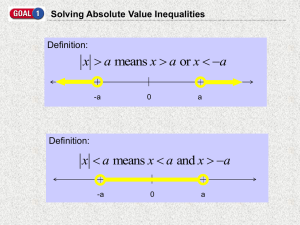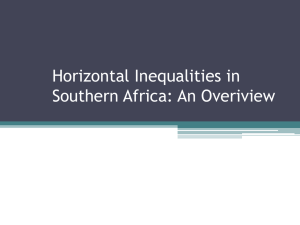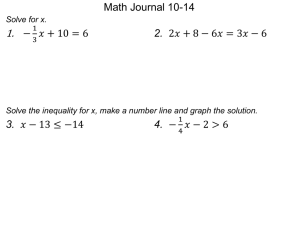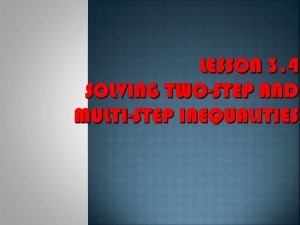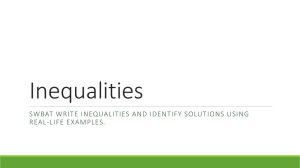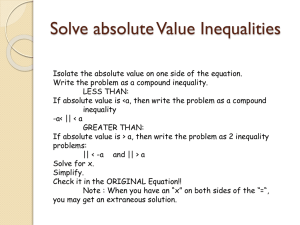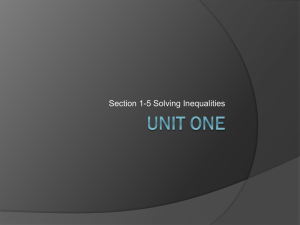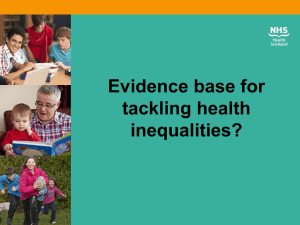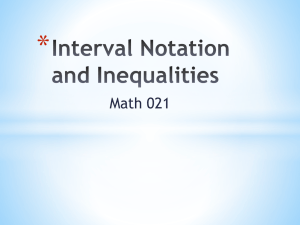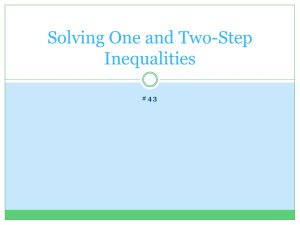Inequality, Peace and Security: implications for post
advertisement
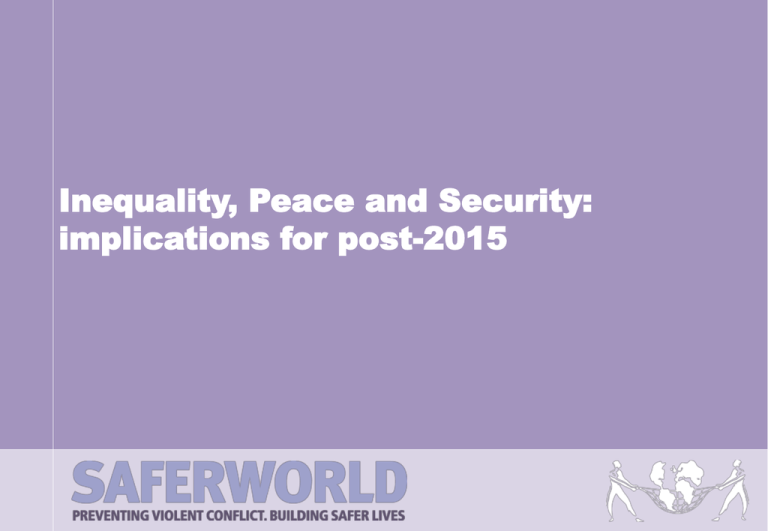
Inequality, Peace and Security: implications for post-2015 What do we mean by peace? 1. Reductions in violence / Negative peace 2. Address drivers / Positive peace 3. Reduce violent insecurity, interpersonal = A holistic vision of peace Saferworld review of evidence: Key issues 1. Reducing violence & making the public feel secure 2. Ending impunity & ensuring access to justice 3. The ability of states to manage revenues & perform core functions effectively & accountably 4. Transparency, accountability & controls on corruption 5. Action on external stresses that drive conflict 6. Shared economic growth & opportunities for decent livelihoods 7. Voice & participation in decision-making 8. Reconciliation & tolerance between different social groups 9. Fair access to social services & resources 10. Ensuring equality between social groups Inequality links to violent conflict and insecurity: Review of evidence • Broadly two types of inequality: • Vertical – between individuals • Horizontal –between social groups (ethnic, religious, regional, age, etc.). Vertical inequality • Strong consensus that it is linked to levels of violent crime • E.g. statistical links between income inequality and homicide, violent robbery – within and between countries • • • Latin America, US IEP, World Bank, Wilkinson and Pickett No strong evidence of link to conflict • IEP, Fearon and Laitin, Collier BUT … Horizontal inequalities (HI) Strong evidence base that different types of HI – and usually combinations of HI – are correlated with conflict risk Horizontal Inequality (HI) • Not new – e.g. Ted Gurr: identity + unmet expectations + relative deprivation • Obvious - conflicts today, World Bank 2011, sense of injustice • But useful: • Conceptual framework • Evidence base • Different perspective (e.g. rich on poor violence). Different types of HI (Frances Stewart) 1. 2. 3. 4. Economic: inequalities in ownership of assets (financial, natural resource-based, human and social) and of incomes and employment opportunities Social: include access to a range of services – e.g. education, health and housing – and inequalities in social outcomes. Political: consist in inequalities in the group distribution of political opportunities and power (e.g. control over executive, representation in parliament, control of army) and inequalities in people’s capabilities to participate politically and voice their needs. Cultural: refer to differences in recognition and (de facto) hierarchical status of different groups’ cultural norms, customs and practices. Economic HI Evidence: • F Stewart – 9 cases – “when ethnic identities coincide with economic [HI], social instability of one sort or another is likely” • G Brown – 31 cases – when regional GDP per capita varies, increased likelihood of conflict • Cases: • Sudan / South Sudan – oil assets, development projects, etc. Social HI Evidence: • Østby: if inequality in terms of years of education increases dramatically, “the probability of conflict more than doubles, to 3.7%,” holding all other variables constant • Cases: • Sri Lanka and education: Tamils and Sinhalese • Kosovo and electricity Political HI Evidence: • • Cederman – 124 ethnic conflicts – “ [politically] excluded groups across all income levels are three times more likely to initiate conflict against the state as compared with included groups that enjoy representation at the center” IEP – Global Peace Index - “some nations have well-functioning governments without the presence of effective democratic institutions. However, in spite of these outliers … the top ten most peaceful nations in the GPI are all well-functioning democracies while most of the bottom ten nations are authoritarian regimes or failed states” Cases: • • Violent protest and youth in Yemen Ivory Coast and citizenship Cultural HI Evidence: • • • • IEP – GPI - finds that levels of peace are correlated with ISS’s measures of both Intergroup Cohesion and Interpersonal Trust. Hudson, Ballif-Spanvill, Caprioli & Emmett - levels of gender inequality, measured by inequities in family law (including marriage, divorce, custody and inheritance) are strongly correlated with conflict and instability. DFID – links between gender violence and gender inequality Cases: • Religious groups in Northern Ireland Some things to keep in mind: 1. Plenty of multi-ethnic or multi-identity countries that are peaceful: what matters is inequality between them 2. HI interrelated with other HI – holistic response 3. How do we define social groups? Built around conflict? 4. Conflict impacts on HI (and other inequalities) 5. Other factors drive conflict beyond inequalities… Implications for peace in post-2015 1. We should be concerned about vertical inequalities, but if we want to prevent conflict through a we must also focus on HI 2. Leaving no-one and no-group behind 3. Strong emphasis on HI in narrative Implications Cont.. 4. One response should be through goal and targets on inequality (goal 10 and target 10.2) 5. But also mainstreamed across goals and targets” • • Economic HI: think not only about growth, but livelihoods, jobs, assets, natural resources Social HI: think about equal and fair access to accountable social services – health, education, security, justice Implications Cont.. • • Political HI: think about participation, accountability, rights and accountable institutions that can respond and perform Cultural HI: think about citizenship, social cohesion, inter-community relations, gender 6. Monitor HI through indicators that are disaggregated by social group as far as possible


